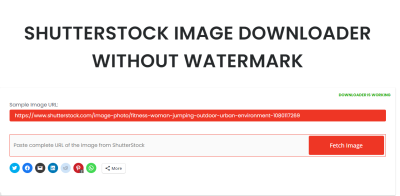Thinking about turning your passion for photography or graphic design into a side hustle? Shutterstock is a popular platform where hobbyists like you can share your creative work and earn some extra cash. You might be wondering, “How much can I really make?” Well, the answer varies depending on your skill, the quality of your images, and how much effort you put in. The great thing is, you don’t need to be a full-time professional to start earning. Let’s explore how you can dip your toes into the world of stock photography and what kind of income you might expect as a hobbyist.
Understanding the Shutterstock Contributor Program

Shutterstock‘s Contributor Program is designed to make it easy for anyone with a camera or design skills to sell their work. When you sign up as a contributor, you become part of a global community of creative artists. The process is straightforward:
- Sign Up: Create a free account on Shutterstock and submit your application to become a contributor.
- Upload Your Content: Once approved, you can start uploading photos, vectors, illustrations, or videos. Quality is key, so focus on sharp, well-composed, and relevant content.
- Review & Approval: Shutterstock reviews your submissions to ensure they meet quality standards. This review process can take a few days.
- Earn Royalties: When your content is downloaded, you earn a royalty fee. The amount varies based on your contributor level and the type of license purchased.
One of the perks of the program is that you maintain full rights to your work, and you can choose which images to upload. As a hobbyist, it’s also worth noting that you don’t need to quit your day job to start earning. Many contributors make a modest but steady income, which can gradually grow as you upload more content and improve your skills.
Keep in mind that while some hobbyists earn just a few dollars a month, others with a larger portfolio and high-quality images can make hundreds or even thousands of dollars annually. The key is consistency, niche focus, and understanding what buyers are looking for. So, don’t be discouraged if your initial earnings are small; every upload is a step toward building your passive income stream on Shutterstock.
Factors That Influence Your Earnings as a Hobbyist Contributor

When it comes to earning money from Shutterstock as a hobbyist, it’s important to recognize that your income isn’t just a fixed number—it varies based on several key factors. Understanding these can help you set realistic expectations and optimize your contributions.
First up, the quality of your submissions plays a huge role. High-quality, sharp, and well-composed images or videos tend to perform better and attract more buyers. Shutterstock‘s review process is quite strict, so investing time in editing and ensuring your content meets professional standards can pay off in the long run.
Next, consider the topic and niche of your content. Some subjects are more popular than others. For example, business and technology images, lifestyle photos, or nature scenes tend to sell more frequently. Conversely, very niche or obscure topics might not get as much traction unless they fill a specific demand.
Another important factor is keywording and metadata. Properly tagging your images with relevant and accurate keywords makes it easier for buyers to find your content. The more discoverable your work is, the higher the chances it will be purchased. Take time to research popular search terms and include them thoughtfully.
Additionally, your frequency of uploads can influence your earnings. Regular contributors tend to build a portfolio that attracts repeat buyers and increases visibility on the platform. Even as a hobbyist, try to upload consistently—quality over quantity still applies, but staying active helps you grow your presence.
Finally, seasonality and current trends can impact sales. For instance, holiday-themed images or trending topics might see a spike in demand during certain times of the year. Keeping an eye on market trends can give you an edge and help you tailor your content to what buyers are actively searching for.
In summary, your earnings are shaped by the quality of your content, niche focus, keywording strategy, upload frequency, and market trends. By paying attention to these factors, you can maximize your earning potential even as a hobbyist contributor on Shutterstock.
Typical Earnings for Hobbyists on Shutterstock
So, what kind of money can you expect to make from Shutterstock as a hobbyist? The honest answer is: it varies a lot. Some hobbyists earn just a few dollars a month, while others manage to make a more noticeable side income. Let’s break down what typical earnings look like for most casual contributors.
First, it’s important to understand Shutterstock’s payment structure. Contributors earn a percentage of the sale price, which depends on your contributor level and the type of content. As a hobbyist, you’re likely to earn around 15% to 30% per sale, depending on your agreement and the licensing type.
Based on these percentages, here’s a rough idea of what you might earn per download:
| Estimated Earnings per Download | Content Type |
|---|---|
| $0.25 – $0.50 | Standard license (most stock photos and videos) |
| $1.00 – $2.00 | Enhanced license (for higher-value or exclusive content) |
Now, how many downloads can a hobbyist expect? Well, it depends on how much and how well you upload. Many hobbyists report earning anywhere from $10 to $100 per month if they upload regularly and their content is somewhat popular. Some might earn less, especially if they’re just starting out, while others who upload niche, high-demand content might see higher figures.
Keep in mind that earnings tend to grow gradually. If you upload consistently, improve your keywording, and target popular topics, your content will likely get more downloads over time. But for most hobbyists, Shutterstock earnings are more of a fun side benefit rather than a full income source.
To give you a clearer picture, here are some typical monthly earning ranges based on contributor activity:
- Casual Hobbyist: $0 – $20
- Moderate Hobbyist: $20 – $50
- Active Hobbyist: $50 – $200+
Remember, these are just ballpark figures. Your actual earnings will depend on your content quality, niche, marketing efforts, and how well your images resonate with buyers. The good news is, even modest earnings can add up over time and make your hobby more rewarding!
Tips to Maximize Your Income from Shutterstock as a Hobbyist
Thinking about turning your hobby into a nice side income on Shutterstock? That’s a smart move! Even if you’re just doing this for fun, there are some simple strategies that can help you earn more without turning it into a full-time gig. Let’s dive into some tips to help you maximize your earnings as a hobbyist contributor.
1. Focus on Quality Over Quantity
Remember, Shutterstock values high-quality images and videos. Invest time in creating sharp, well-lit, and properly composed content. Use good equipment if possible, and pay attention to details like exposure, focus, and editing. Better quality content will attract more buyers and fetch higher prices.
2. Find Your Niche
Think about what subjects you’re passionate about or skilled in. Whether it’s nature, travel, food, or lifestyle, specializing can help you stand out. Niche content often attracts dedicated buyers looking for specific themes, increasing your chances of sales.
3. Keep Up with Trends
Stay updated on what’s popular. Browse Shutterstock’s trending sections or check out what other top contributors are uploading. Incorporate current themes, seasonal topics, or trending styles into your work to boost relevance and sales.
4. Use Relevant Keywords
When uploading, spend time on keywording. Use descriptive, specific keywords that accurately represent your content. Good keywords help your images appear in search results, making it more likely buyers will find and purchase your work.
5. Upload Regularly
Consistency is key. The more quality content you upload, the higher your chances of earning. Set a manageable schedule—whether it’s weekly or biweekly—and stick to it. Over time, your portfolio will grow, and your visibility will increase.
6. Take Advantage of Shutterstock’s Contributor Resources
Shutterstock offers tutorials, tips, and community forums. Use these resources to learn new skills, stay inspired, and improve your submissions. The more you learn, the better your content will become.
Remember, as a hobbyist, your goal is to enjoy the process while earning extra income. Implementing these tips can help you make the most out of your efforts without feeling overwhelmed.
Pros and Cons of Earning Money on Shutterstock as a Hobbyist
Getting paid for your creative work on Shutterstock as a hobbyist can be exciting, but it’s good to weigh the benefits and drawbacks. Let’s explore some of the main pros and cons so you can decide if it’s the right fit for you.
Pros
- Flexibility and Low Pressure: Since you’re doing it as a hobby, you set your own pace. No deadlines or quotas—upload when you want, how often you want.
- Extra Income: Even a few sales can add up over time. It’s a great way to monetize your passion without much extra effort.
- Skill Development: Improving your photography, videography, or design skills can be rewarding and beneficial beyond just earning money.
- Portfolio Building: Your growing collection can serve as a visual journal of your work and creativity, which could lead to other opportunities later.
- Global Reach: Shutterstock offers access to a worldwide marketplace, so your work can be seen and purchased by people from all over the globe.
Cons
- Lower Earnings per Item: As a hobbyist, your earnings per download are generally lower compared to exclusive or professional contributors.
- Time Investment: Building a sizable portfolio takes time, and it might not generate substantial income immediately.
- Marketplace Competition: With thousands of contributors, standing out can be challenging. High-quality, niche content tends to perform better.
- Limited Control Over Pricing: Shutterstock sets the pricing structure, so you might not earn as much per download as you would from selling directly to clients.
- Potential for Frustration: If your work doesn’t sell much, it can be discouraging. Remember, earnings are often unpredictable and vary widely.
All in all, earning money from Shutterstock as a hobbyist can be a rewarding experience, especially if you enjoy creating and sharing your work. While it might not replace a full-time income, it’s a fantastic way to turn your passion into a little side hustle, provided you’re aware of the challenges involved. Keep creating, stay patient, and have fun with it!
Conclusion and Final Thoughts on Earning Money from Shutterstock as a Hobbyist
In summary, earning money from Shutterstock as a hobbyist can be a rewarding experience, but it requires dedication, consistency, and understanding of the platform’s best practices. While the income potential varies based on the quality and quantity of your submissions, many hobbyists find that even modest earnings can supplement their income or fund their creative pursuits. It’s important to set realistic expectations and focus on creating high-quality, unique content that appeals to buyers.
Here are some key takeaways:
- Income varies widely depending on the type of content, its popularity, and licensing options.
- Consistent uploads and portfolio growth increase your chances of higher earnings over time.
- Understanding licensing and keywords enhances discoverability and sales potential.
- Engaging with the community and keeping up with trends can give you an edge in the marketplace.
While it may not make you rich overnight, turning your hobby into a supplementary income stream from Shutterstock is achievable with patience and dedication. It’s a great way to monetize your passion for photography or design while building a portfolio that can grow over time. Ultimately, the key is to enjoy the process and view it as an opportunity to develop your skills and share your creativity with a global audience.


